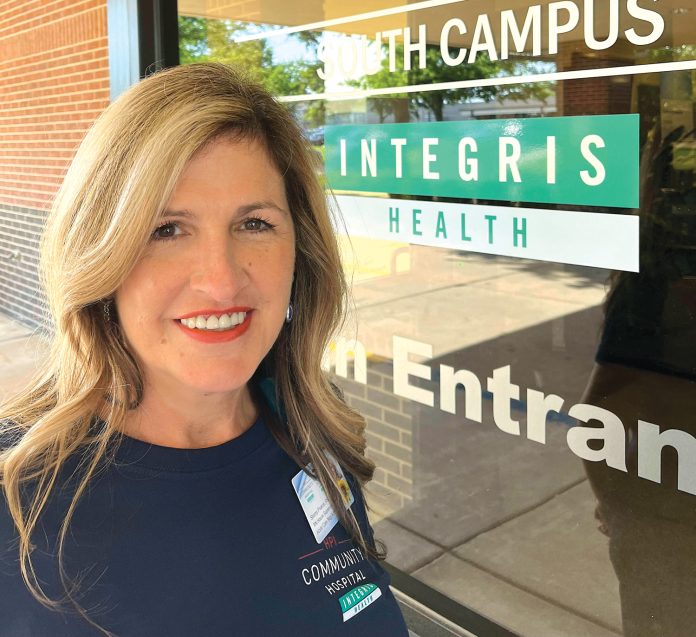
Story and photo by James Coburn, Staff Writer
Maintaining the general flow of incoming and outgoing patient care at Community Hospital South, located in Oklahoma City, comes from the experienced and well-organized leadership of Stormy Pearce, RN, and house supervisor. And in doing so, she appreciates the initiative taken by her synergetic nursing staff who is dedicated to patient centered care.
“Being compassionate, talking to patients and their families, there’s not a day that I walk out of here that I don’t feel satisfied by a connection throughout the day or just a talk with a patient,” Pearce said. “There’s always something going on. And patients are appreciative. Their family members are very appreciative of you taking the time out to talk to them.”
Pearce’s enthusiastic persona is an effective resource for the staff’s education and guidance. Her preference is to spend most of her time with her staff out of her office. She can often be found sitting beside her unit secretary where nurses pass by frequently.
“I like to be visible where the staff can see me and can ask questions,” Pearce said. “If they need something they will say, ‘Hey Stormy, can you come medicate this patient,’ I help them in any way that I can.” (story continues below)
Also, she assists in the ER whenever it’s busy and nurses need help. There could be anything from a code, to starting IVs for blood cultures. The ER has five beds, but hospital rooms can be used whenever a need arises. There is also a three-bed ICU.
“I just try to help, actually the entire facility,” she said while two patients were in the ICU.
A typical day within the hospital will have up to 10 hospital nurses at work with a ratio of four nurses to every patient, Pearce said. That type of ratio brings exceptional patient care.
On Fridays the nurses wear t-shirts which is a nice change from wearing their scrub top, she said. The new shirts boast of Community Hospital’s 5-star rating for overall quality and patient satisfaction. Also, the Joint Replacement Excellence Award, and the hospital’s award of being among America’s 100 Best Hospitals for Orthopedic Surgery from The Centers for Medicare and Medicaid Services (CMS) assigned “Star Ratings”.
“We have a phenomenal group of nurses, patient care techs, unit secretaries, and our physical therapists. They come to work — a lot of them have been here for ages, like our physical therapist for 20 years. A lot of the nursing staff here have been here from 10 to 15 years,” Pearce continued. “So, their hard work, their dedication and excellent patient care add up. We have a lot of agency contract nurses, too, that are absolutely amazing. I feel like we are blessed that we’re not working short-handed. We just have an amazing group of staff here that are dedicated to taking care of the patients.”
Each one brings something different from their experiences, she continued. Together, they blend cohesively and effectively in a team effort.
“Our name is Community Hospital, but I feel like we’re a family belonging to a community. We’re all one little, yet big community. We’re all here to help,” Pearce said. “The director of nursing is great at each facility. They’re all amazing.”
Whenever Pearce needs answers regarding an issue, she can pick up the phone at any hour for a quick response.
Caring for people where they are in life is what led Pearce to become a nurse. Her desire to help people flows from a compassionate heart.
Pearce began her nursing career as a licensed practical nurse in 2007 before becoming a registered nurse in 2010. Memorial Hospital in the Comanche County emergency room was where her career began as an LPN. She was hired to work at SSM Health St. Anthony Hospital soon after earning her RN credential. In 2016 Pearce was hired by Community Hospital’s North as house supervisor at night before coming to Community Hospital South to work the day shift in 2022.
Patients are admitted for different reasons. They bring different levels of anxiety or relief when being admitted to the hospital.
“I think we listen to them,” she said of easing their tension. “As far as an ER patient, I just kind of get to their level, ask them what their fears are, and just try to help them and their family. You just talk to them and understand what their thoughts are, their fears are, and then work through the process with them.”
Nurses give patients a specific timeline of what processes will take place. The constant updates given to patients doesn’t leave them wondering with fear of the unknown.
“I think that will help ease their fears,” she said.











